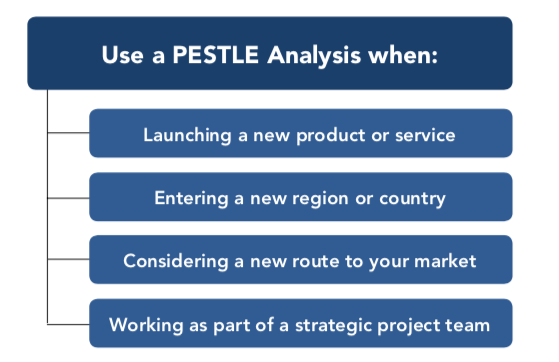
What is it?
The PESTLE Analysis provides a framework for investigating and analysing the external environment for an organisation. The framework identifies six key areas that should be considered when attempting to identify the sources of change. In general, the organisation has no control over this external factors, but it has to know and understand the impact and implications of these factors.
Why do it?
Nowadays the business environment is changing faster than ever before. The organisations must analyse the implications of these changes and modifying the way they react to them, and adapt the business strategy.
PESTLE Analysis is a well known tool for identifying these external factors, which can be used to help you consider Political, Economic, Social, Technological, Legal, and Environmental issues.

What Should the Results be?
The purpose of the PESTLE Analysis is to identify issues that fit two key criteria:
- They are outside the control of the organization
- They will have some level of impact on it
The PESTLE analysis will offer the opportunity to have a much clearer understanding of the organisation’s environment. It also provides a big picture view that helps the organisation to assess the potential risks that it faces and to know what impact current external factors will have.
The framework of this analysis is formed by six factors: Political, Economic, Sociological, Technological, Legal, and Environmental factors. The organisation will need to consider the implications of any external factors identified as well as the likelihood of them occurring.
The process
The process organisation is likely to adopt when using the PESTLE technique is a relatively simple one:
- Brainstorm and list key issues that are outside the organisation’s control.
- Broadly identify the implications of each issue.
- Rate its relative importance to the organisation (e.g. critical, extensive, important, significant, moderate, or insignificant).
- Rate the likelihood of it occurring (e.g. certainty, extremely likely, likely, potential, remote possibility, or will not transpire).
- Briefly consider the implications if the issue did occur.

Advantages
- provides a simple and easy-to-use framework for external analysis
- involves cross-functional skills and expertise
- helps to reduce the impact and effects of potential threats to the organisation
- aids and encourages the development of strategic thinking within the organisation
- provides a mechanism that enables the organisation to identify and exploit new opportunities
- enables the manager yo assess implications of entering new markets both nationally and globally
Disadvantages
- users can oversimplify the information that is used for making decisions
- the process has to be conducted regularly to be effective and often organisations do not make this investment
- users must not succumb to ‘paralysis by analysis’ where they gather too much information and forget that the objective of this tool is the identification of issues so that action can be taken
- organisation often restrict who is involved due to time and cost considerations. This limits the technique’s effectiveness as a key perspective may be missing from the discussions
- Users’ access to quality external information is often restricted because of the cost and time needed to collate it
- Assumptions often form the basis for most of the data used, making any decision made based on such data subjective
Tips
- The PESTLE tool is a powerful technique for analysing the organisation’s environment but it should represent just one component of a comprehensive strategic analysis process
- The PESTLE factors combined with external micro-environmental factors and internal drivers, can be classified as opportunities and threats in a SWOT Analysis.
- If the PESTLE Analysis identifies factors that require internal changes to the organisation, then these will need to be investigated further using tools like the Boston Matrix.
- There are several common variations of the PESTLE Analysis: ETPS—Economic, Technical, Political, and Social, STEP—Strategic Trend Evaluation Process, STEPE—Social, Technological, Economic, Political, and Ecological, PEST—Political, Economic, Social, and Technological, STEEPLE—Social, Technological, Economic, Ethical, Political, Legal, and Environmental, PESTLIED—Political, Economic, Social, Technological, Legal, International, Environmental, and Demographic, STEEPLED—Social, Technological, Economic, Environmental, Political, Legal, Educational, and Demographic.
References
Cadle, J., Paul, D. and Turner, P. (2010), Business Analysis Techniques, 72 Essential Tools forSuccess, BCS The Chartered Institute for IT.
Johnson, G., Whittington, R. and Scholes, K. (2009), Exploring Corporate Strategy with MyStrategyLab, Financial Times/Prentice Hall.
McDonald, M. and Wilson, H. (2011), Marketing Plans: How to Prepare Them, How to Use Them, 7th Edition, John Wiley.